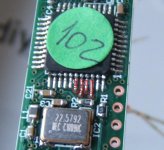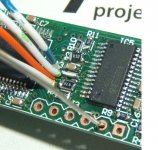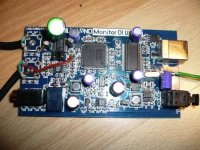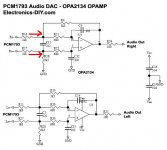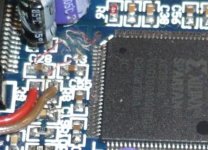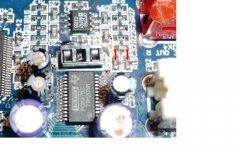I have a general question about I2S that I thought I would ask since people in this thread are talking about implementing it with this device. It is usually used in very short distances, over traces, between input receivers and the DAC chip. Does I2S perform to spec over longer distances? Is there a length where I2S becomes flawed or unusable?
Thank you for sharing your knowledge and experience.
-Aaron.
Thank you for sharing your knowledge and experience.
-Aaron.
I'm currently listening some good music flowing from my PC thru my HiFace, some small wires channeling i2s to Twisted Pear OPUS DAC (Wolfson 8742), a pair of mighty ITT PMT2R caps, a SSTART (GRollins  ) preamp, an F4 clone (thank you, Nelson 😎) powering a pair of Altec VOT (sort of, the woofer are mounted in a dipole).
) preamp, an F4 clone (thank you, Nelson 😎) powering a pair of Altec VOT (sort of, the woofer are mounted in a dipole).
And I really enjoy.
I cannot made any comparison, but I'm (finally) able to listen to the 24/176 files, finally free from the limits of PCM270*, of the TAS1020B, and of the ASIO drivers.
HiFace drivers are proprietary, yes, but I don't mind. Also Wavelenght make use of proprietary drivers to go asynchronous, but only up to 96KHz.
The chip used (Cypress) is more modern, and the brilliant use of modern technologies is what I asked for, to listen to the liquid music.
Back to technical topics (even if I'm all but a technician), it's quite difficult (but not impossible) stealing I2s from the HiFace, and the result is remarkably good, no clik or hiss, and a sound quality miles above PCM2707-based USB receivers.
ASAP I'll post some pics
Ciao
Guido
 ) preamp, an F4 clone (thank you, Nelson 😎) powering a pair of Altec VOT (sort of, the woofer are mounted in a dipole).
) preamp, an F4 clone (thank you, Nelson 😎) powering a pair of Altec VOT (sort of, the woofer are mounted in a dipole).And I really enjoy.
I cannot made any comparison, but I'm (finally) able to listen to the 24/176 files, finally free from the limits of PCM270*, of the TAS1020B, and of the ASIO drivers.
HiFace drivers are proprietary, yes, but I don't mind. Also Wavelenght make use of proprietary drivers to go asynchronous, but only up to 96KHz.
The chip used (Cypress) is more modern, and the brilliant use of modern technologies is what I asked for, to listen to the liquid music.
Back to technical topics (even if I'm all but a technician), it's quite difficult (but not impossible) stealing I2s from the HiFace, and the result is remarkably good, no clik or hiss, and a sound quality miles above PCM2707-based USB receivers.
ASAP I'll post some pics
Ciao
Guido
It would be awesome if they would also release this technology as a DIY kit (on a separate board, with external power support) so we can integrate it in DACs and skip the conversion to SPDIF.
One can only wish. 🙂
gevorg,
This project is born, as I've correctly understood, after a specific request from Pierre Bolduc (of italian review Audiophile Sound) of a no-brain device, a black (white, in fact) box able to enlarge the market of liquid music endusers.
If you - like me - like DIY then you must be brave enough to open the box...
Stay tuned, my lab-HiFace could in the (next, see my avatar) future disclose some secret (you say external power?).
Only to clarify: I have no link or common interest with M2Tech, I've opened my device at my own risk and without the (official) blessing of the designer.
Ciao
Guido
I'm currently listening some good music flowing from my PC thru my HiFace, some small wires channeling i2s to Twisted Pear OPUS DAC (Wolfson 8742), a pair of mighty ITT PMT2R caps, a SSTART (GRollins) preamp, an F4 clone (thank you, Nelson 😎) powering a pair of Altec VOT (sort of, the woofer are mounted in a dipole).
And I really enjoy.
Hi Guido!
finally you got it working! it seems very good.. pls tell us more about the sound 😀
btw good job
ciao
Vale
Last edited:
Hi Guido,
any chance you post a picture or explain on which chip/pins you get the I2S signal
thanks,
cdfr
any chance you post a picture or explain on which chip/pins you get the I2S signal
thanks,
cdfr
Yes, picture please.. 🙂
One important question, do you have to break the casing in order to open the hiface?
One important question, do you have to break the casing in order to open the hiface?
If CMOSout levels in practice >0.7-1mIs there a length where I2S becomes flawed or unusable?
Hi Guido,
any chance you post a picture or explain on which chip/pins you get the I2S signal
thanks,
cdfr
later, be patient 🙂
I intend to write an "how to" post with explanatory pictures, give me some time.
In the meantime you could order the hiface 😉
Ciao
Guido
Yes, picture please.. 🙂
One important question, do you have to break the casing in order to open the hiface?
Hi okkyn
In fact yes, but in any case, modding the device, the warranty is void (see first post)
Ciao
Guido
I just noticed this thread now.
I have the Musiland 01US which I have modded as follows:
- powered from external 5V supply (currently SMPS) but will be trying Salas Shunt - best upgrade so far for digital out
- tapped I2S signals & ready to link to external DAC (haven't done so yet for various reasons)
- have just received a Crystek 24MHz clock to substitute for the on-board 24MHz crystal : this will be run off a 3.3V battery
- substituted the op-amp output stage of the PCM1793 DAC with differential Vout direct to transformer: this was the biggest upgrade to the analog out sound.
- I was looking to use a ADUM4160 USB isolator but I'm told that it won't work even at the lower 24/192 speed?
I'll post some pics if anyone is interested.
I wonder how it would compare to the fully modded HiFace? BTW, what chips are used in the HiFace - a Xilinix & Cypress, but what model?
Valeriano, good to see you here - I've been trying to email you but my emails are bouncing back from your old email address.
Guido, any more pics/updates?
I have the Musiland 01US which I have modded as follows:
- powered from external 5V supply (currently SMPS) but will be trying Salas Shunt - best upgrade so far for digital out
- tapped I2S signals & ready to link to external DAC (haven't done so yet for various reasons)
- have just received a Crystek 24MHz clock to substitute for the on-board 24MHz crystal : this will be run off a 3.3V battery
- substituted the op-amp output stage of the PCM1793 DAC with differential Vout direct to transformer: this was the biggest upgrade to the analog out sound.
- I was looking to use a ADUM4160 USB isolator but I'm told that it won't work even at the lower 24/192 speed?
I'll post some pics if anyone is interested.
I wonder how it would compare to the fully modded HiFace? BTW, what chips are used in the HiFace - a Xilinix & Cypress, but what model?
Valeriano, good to see you here - I've been trying to email you but my emails are bouncing back from your old email address.
Guido, any more pics/updates?
I just noticed this thread now.
- I was looking to use a ADUM4160 USB isolator but I'm told that it won't work even at the lower 24/192 speed?
I'll post some pics if anyone is interested.
I wonder how it would compare to the fully modded HiFace? BTW, what chips are used in the HiFace - a Xilinix & Cypress, but what model?
Valeriano, good to see you here - I've been trying to email you but my emails are bouncing back from your old email address.
Hi John!
how are you? nice to see you 😀 (btw my private email is down for maintenance, I'm sending you my regular email address)
ADUM is rated USB/2.0 upto 12Mb/s.. m2tech runs at 480Mb/s so no chance to use it, probably same apply to musiland, don't know. what speed is specd?
btw I modded my m2tech with very good results: i2s out and external 5V from standard regulator+oscon.
I'm doing some more tests, now..I'll post results when completed.
soon
ciao
Vale
Here are some pics of my Musiland 01US (the one with on-board PCM1793 DAC)
First shot shows the full board which I've done the following to:
- replaced digital PS coupling caps with OSCONS
- analog PS decoupling to PCM DAC with Nichicon Muse
- the Brown & Red wires are from the differential Vout of the DAC to the twin co-ax that connects to a transformer - so this is the new output stage & sounds WAY better than the op-amp o/p stage. I needed to move the two 1K8 smd resistors from their pads (see attached schematic). This now disconnects the op-amp o/p stage but if I want to reconnect I just need to jumper from where the wires are connected to the moved smd Rs. Easily reversible mod. The other channel has thinner wires running under the board. These wires connect to isolated pads that were exposed when the RCA connectors were desoldered from the board.
Last photo shows a close-up of the Xilinx chip where the I2S lines run to the DAC. I removed some of the overlying varnish on these tracks in a staggered manner, applied a touch of flux & solder & then soldered some fine wires onto these tracks (make sure you have tinned the wire & apply some flux to the wire - line it up on the exposed, soldered track & just a tip of a soldering iron will do the job - not difficult with a magnifier. I run the wires through vias, to the bottom of the board and connect to a molex push on connector
First shot shows the full board which I've done the following to:
- replaced digital PS coupling caps with OSCONS
- analog PS decoupling to PCM DAC with Nichicon Muse
- the Brown & Red wires are from the differential Vout of the DAC to the twin co-ax that connects to a transformer - so this is the new output stage & sounds WAY better than the op-amp o/p stage. I needed to move the two 1K8 smd resistors from their pads (see attached schematic). This now disconnects the op-amp o/p stage but if I want to reconnect I just need to jumper from where the wires are connected to the moved smd Rs. Easily reversible mod. The other channel has thinner wires running under the board. These wires connect to isolated pads that were exposed when the RCA connectors were desoldered from the board.
Last photo shows a close-up of the Xilinx chip where the I2S lines run to the DAC. I removed some of the overlying varnish on these tracks in a staggered manner, applied a touch of flux & solder & then soldered some fine wires onto these tracks (make sure you have tinned the wire & apply some flux to the wire - line it up on the exposed, soldered track & just a tip of a soldering iron will do the job - not difficult with a magnifier. I run the wires through vias, to the bottom of the board and connect to a molex push on connector
Attachments
I also put a socket (seen in the pic) on the Vcom pin of the PCM1793 as I heard that this capacitor influenced the sound - I can't say I've noticed much of a noticeable change among caps - maybe a better HF response using film?
I've marked with two red lines, the two 1k8 Rs that are moved down to join with either side of the smd cap, exposing the pads that the two wires are soldered to for the transformer output
I've marked with two red lines, the two 1k8 Rs that are moved down to join with either side of the smd cap, exposing the pads that the two wires are soldered to for the transformer output
Attachments
Nice work jkeny!
Thanks, I'll report back on my next round of mods:
- Crystek 24MHz clock
- Sescom output transformers
- investigations into battery Vs Shunt regs
- Status
- Not open for further replies.
- Home
- Source & Line
- Digital Source
- M2TECH Hiface USB->SPDIF 24/192Khz asynch
